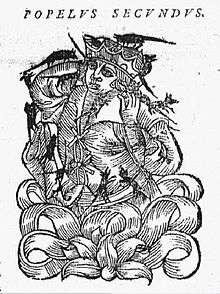Popielids
The Popielids (Polish: Popielidzi) were a legendary[1] ruling dynasty of either the Polans, Goplans or both tribes, founded by Leszko II, the son of Leszko I. They supposedly ruled the lands of Poland prior to the start of the Piast dynasty.
The first document mentioning the dynasty, as well as the last of its members, is the medieval chronicle of Gallus Anonymus.[2] According to it, Popiel II was ousted by a certain Piast the Wheelwright, who in turn gave power to his son, Siemowit. According to a popular legend, Popiel II was then eaten by mice in his tower on the Gopło lake.[3] The predecessors of Popiel II are mentioned by Wincenty Kadłubek and Jan Długosz.
Because of a lack of tangible archaeological evidence of the dynasty's existence,[4] little is known of it. Some scholars speculate, basing mostly on the linguistic analysis of personal names, that the Piasts (whose name in Slavic means the one to care for or the one to educate) were initially Popielid mayors of the house responsible for education of the princes, in a similar relation as the Carolingians and Merovingians.[5] Some also speculate that the legend of carnivorous mice (myszy in modern Polish) might contain a grain of truth as the word bears semblance to the name of the first historical ruler of the Piasts, Mieszko (whose name meant bear in old Polish, but see the name section of the article on Mieszko I for controversy on the subject).
Members
Leszko I > Leszko II > Leszko III > Popiel I > Popiel II > Popiel > Bolesław > Lech > Wratysław > Władysław > Wratysław > Oddon > Barwin > Przybysław > Przemysław > Jaksa > Semian > Siemowit > Siemomysł > Bogdal > Spicygniew > Spicymir > Zbigniew > Sobiesław > Arlemiusz > House of Sobieski > Wizymir > Czestmir > Wisław
Notes
- ↑ Aleksander Brückner (1897). "O Piaście". Rozprawy Wydziału Historyczno-Filozoficznego Akademii Umiejętności w Krakowie (in Polish). XXXV: 307–352.
- ↑ (English) (Latin) Gallus Anonymus; Knoll, Schoer; Bisson, Schaen (2003). The Chronicles and Deeds of the Dukes Or Princes of the Poles. Central European University Press. pp. 17–22. ISBN 978-963-9241-40-4.
- ↑ Jan Bondeson (2004). Two-Headed Boy, and Other Medical Marvels. Cornell University Press. pp. 91–92. ISBN 978-0-8014-8958-7.
- ↑ Jerzy Lukowski; Hubert Zawadzki (2001). A Concise History of Poland. Cambridge: Cambridge University Press. ISBN 978-0-521-55917-1.
- ↑ Tadeusz Wojciechowski (1895). "O Piaście i piaście". Rozprawy Wydziału Historyczno-Filozoficznego Akademii Umiejętności w Krakowie (in Polish). XXXII: 171–221.
References
- Czesław Deptuła (November–December 1973). "Średniowieczne mity genezy Polski". Znak (in Polish). XXV (233–234): 1365–1403.
- Jan Popiel, Sławomir Popiel (1998). "Popiel". King Popiel.

